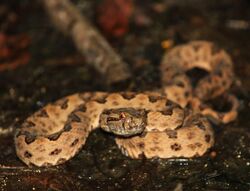Biology:Protobothrops elegans
| Protobothrops elegans | |
|---|---|

| |
| Scientific classification | |
| Domain: | Eukaryota |
| Kingdom: | Animalia |
| Phylum: | Chordata |
| Class: | Reptilia |
| Order: | Squamata |
| Suborder: | Serpentes |
| Family: | Viperidae |
| Genus: | Protobothrops |
| Species: | P. elegans
|
| Binomial name | |
| Protobothrops elegans (Gray, 1849)
| |
| Synonyms | |
| |
Protobothrops elegans is a venomous pitviper species endemic to Japan in the southern Ryukyu Islands.[1][3] No subspecies are currently recognized.[3][4] Common names include: elegant pitviper,[1][3][4][5] Sakishima habu (サキシマハブ),[6] and elegant tree viper.[7]
Description
Scalation includes 25 (sometimes 23) rows of dorsal scales at midbody, 179–192 (males) or 182–196 (females) ventral scales, 63–90 subcaudal scales, and 8 (sometimes 7 or 9) supralabial scales.[5]
During 1965–2011, 2447 snakebites from this snake are reported with one fatality.[8]
Geographic range
It is found in Japan in the southern Ryukyu Islands, specifically in the Yaeyama Islands.[1] The type locality is unknown. Boulenger listed it as "---- ?" while Gray's original 1849 description gives "West Coast of [North?] America." A restriction to "Ishigaki-Shima [Ryukyu Islands, Japan]" was proposed by Stejneger (1907).[2]
See also
References
- ↑ 1.0 1.1 1.2 1.3 Ota, H.; Kidera, N. (2018). "Protobothrops elegans". IUCN Red List of Threatened Species 2018: e.T96265465A96265478. doi:10.2305/IUCN.UK.2018-2.RLTS.T96265465A96265478.en. https://www.iucnredlist.org/species/96265465/96265478. Retrieved 15 August 2022.
- ↑ 2.0 2.1 McDiarmid RW, Campbell JA, Touré T. 1999. Snake Species of the World: A Taxonomic and Geographic Reference, Volume 1. Herpetologists' League. 511 pp. ISBN:1-893777-00-6 (series). ISBN:1-893777-01-4 (volume).
- ↑ 3.0 3.1 3.2 Protobothrops elegans at the Reptarium.cz Reptile Database. Accessed 15 August 2022.
- ↑ 4.0 4.1 "Trimeresurus elegans". Integrated Taxonomic Information System. https://www.itis.gov/servlet/SingleRpt/SingleRpt?search_topic=TSN&search_value=1058438.
- ↑ 5.0 5.1 Gumprecht A, Tillack F, Orlov NL, Captain A, Ryabov S. 2004. Asian Pitvipers. GeitjeBooks. Berlin. 1st Edition. 368 pp. ISBN:3-937975-00-4.
- ↑ Mehrtens JM. 1987. Living Snakes of the World in Color. New York: Sterling Publishers. 480 pp. ISBN:0-8069-6460-X.
- ↑ Brown JH. 1973. Toxicology and Pharmacology of Venoms from Poisonous Snakes. Springfield, Illinois: Charles C. Thomas. 184 pp. LCCCN 73-229. ISBN:0-398-02808-7.
- ↑ Seiko Matsuda. "Error: no
|title=specified when using {{Cite web}}" (in ja). Okinawa Prefectural Institute of Health and Environment, Hygiene Science Group Eiko Maho. http://www.eikanken-okinawa.jp/seitaiG/habu/houkokusyo/H23houkoku.pdf.
Further reading
- Gray, J.E. 1849. Catalogue of the Specimens of Snakes in the Collection of the British Museum. Trustees of the British Museum. London. xv + 125 pp. (Craspedocephalus elegans, p. 7.)
Wikidata ☰ Q46108 entry
 |


